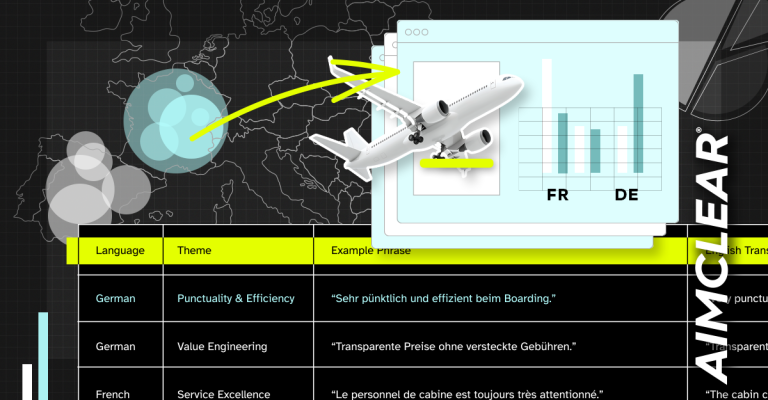Welcome to AIMCLEAR‘s coverage of #SMX West 2013! Mark it up, baby! The afternoon of Day 2 brought a tech-tastic crowd together for Schema 201: Real World Markup For Success, moderated by Elisabeth Osmeloski, Managing Editor, Search Engine Land and featuring panelists Benu Aggarwal, President, Milestone Internet Marketing, Matthew Brown, Head of Special Projects, SEOmoz, and Barbara Starr, Vice President of Product Marketing, Algebraix Data.
This session was perfect for marketers and site-owners who don’t need to be convinced that semantic markup is a fascinating and important factor of SEO. They’re already on board, and ready to learn the most effective ways to leverage its code-tastic power. Speakers were amped up to share their own best practices regarding semantic markup and tips for fine-tuning microdata to better convey trust and authority to search engines. Each came armed with insight and data-packed case studies. The underlying theme of it all? Marking up everything (within reason) and painstaking attention to detail can have a dramatically positive affect on your brand visibility.
AIMCLEAR live-tweeted the spirited session via @beebow. Read on for the geektastic goods.
Barbara was up first. Her presentation was all about Schema and real world markup for success… from a search engine perspective.
Okay, so it’s worth noting that bots don’t talk to humans. Therefore, they have to get all the information they possibly can from the information humans put into their webpage data. Ya dig?
Some Background On Structured Markup
- If you make search engines happy, users and site-owners will be happy!
- One way to make them happy is to feed them with as much context and data as possible.
- One (great) way to do that is… structured markup!
- Search engines can directly extract information from structured markup to enhance SERP display.
- This makes for a much more engaging experience for the user.
- The concept of structured markup dates back to 2008, with Yahoo’s roll-out of Search Monkey.
- A year later, Google launched Rich Snippets.
Barbara recommended checking out Sindice to stay abreast of Schema changes. “Millions of websites mark up their content using
RDF, Microformats, Microdata, Schema.org, RDFa, Opengraph and more. Sindice helps you find, understand and integrate
with their content.”
What Does Semantic Markup Mean For A Search Engine?
And now! Presenting, the world of real world markup… as told by a search engine bot. (Whenever you see “I,” that’s coming from the point of view of a search engine bot!)
Prior to Schema…
- So… many… conflicting… markup… vocabularies 🙁 Everyone keeps throwing different terms at me 🙁
- I have to align these different terms internally and try to make sense of the multiple syntax formats (microdata, microformats, RDFa)…
- This is not fun. This makes me sad. I need a solution. Let’s make a solution. Let’s call it… SCHEMA!
After the creation of Schema…
- Now I have one language to follow! Ahh, Schema brings order to chaos. This makes it sooo much easier to do all I used to do.
- I can search directly on consumed metadata! I can also provide direct answers to queries by searching on consumed, verified, and validated information. This allows me to put results RIGHT in the search engines.
- I can even aggregate answers or deduce them (like a timeline of events)! Yes, the Knowledge Graph is capable of understanding time and place. In other words, yep, I’m a computer learning real world concepts, ultimately making me more intelligent.
- I can also leverage this data to express more relevant answers in the long tail of search.
- Hey, you, SEOs! This gives you a big advantage. If markup is consumed in the long tail, and that’s now exposed, you can find a mechanism to really leverage this.
- I can use markup to assist in interpreting a user query! User intent is huge. I can parse out different Schema and entities, and use that input to provide the best possible results!
- I can detect relevancy signals! In other words, I know what content to show what audience.
- I can use markup in conjunction with machine learning techniques to train other components. (This isn’t perfect yet, but it works well so far!)
- I can leverage metadata for better image search! And I can combine it with computer vision techniques!
- I can enhance users shopping experience!
The Knowledge Graph
- I love the knowledge graph! It is a beautiful, engaging displays for users.
- People never even have to click through to your content if they get all the info they want on my SERP 🙂 (Sneaky…)
- I can even start deriving associations or relationships between entities! And my deductions are becoming more and more sophisticated as time goes on.
- I find the KG so helpful that I would be really like to be able to keep all that validated verified information to myself!
- Hmmm, how can I do that? Introducing, the data highlighter for event data! The information is valuable only to me and not to any other bots. (Can you believe I have been accused of highjacking structured markup!?)
Semantic Markup & The Signals It Sends…
- It is crucial to enrich your content and data with rich markup. It sends signals to us!
- Markup as much as you can. Ensure the following matches: on-page markup , data in any feeds you submit, information visible to the user or human. Failure to markup everything might exclude you from some very important SERPs!
- Look at the filters that show up in the left hand side of Google Shopping for a query like “black dress”. Clearly, if you do not populate the “color” attribute for your product, you can’t show up in that vertical. If you don’t markup, you effectively get filtered out at high-level results. Visibility is more important! The best way to achieve that is to enrich your content.
- This same type of logic applies to various verticals– however, at a higher level in search taxonomy, so to speak.
- For example, searching in the recipe vertical, if you have not entered recipe information, results will be “filtered out” from that SERP set.Boo!
- Adding context in search verticals helps me serve up relevant information.
- Consequently, drilling down into a query using more and more filters enables me to better redefine my understanding of the intent of your search! This helps me build trust in you, and trust is a huge signal for me 🙂 .
- Look at the correlations between Google’s search verticals and consumed data. Visibility and mis-perceived information exposure outweighs “risk,” as the exposure is controllable.
Structured Markup & Social
- My social counterparts have been leveraging structured markup (RDFa) for their Open Graph protocol for quite some time!
- The open graph protocol enables you to integrate webpages into the social graph.
- They also leverage it in their newly released Graph Search! Not only that, they are building an entity graph not dissimilar from my Knowledge Graph!
Key Takeaways
- Markup everything you can within reason and your business priorities
- Make sure everything you markup is also visible to human end user. If not, you’re cloaking!
- Make sure your info is fresh and there are no stale links
- Don’t try to spam me! You will run the risk of a penalty and also lose my trust – the latter is an important signal in and of itself!
- Ensure your data is of the highest possible quality – cleaned and scrubbed!
Next up, Matthew. He was set to discuss the current status of Schema.
In terms of markups, what’s the latest with Google, Bing, and Facebook?
- Check out Webmaster Tools Rich Snippets Types for the most accurate / up to date news on what rich snippet types are supported (such as breadcrumbs, events, music, pagination, people, products, recipes, reviews, etc.)
- When you’re ready to implement, head to SEO Gadget’s ultimate Schema resource.
Troubleshooting for Schema
If your markup isn’t appearing and you need help, check out Webmaster Tools’s troubleshooting guide. Think you don’t need help? Well… did you know, if your site has very few pages or very few pages with marked-up structured data, it may not be picked up by the rich snippets system. For example, if your site has 1000 pages and you only test semantic markups on 10, or even 50 pages, Google may think that’s not enough, and therefore, it might not catch Google’s eye. So yeah, there are non-obvious things you may need to troubleshoot! (Solution to this particular scenario… if you’re doing to test semantic markup, do it on every page of the site, dude!)
If all else fails, and no troubleshooting helps, try Google’s mystery form (like their Reconsideration form). Matt pointed out that sometimes they get back to you, most times they don’t. But a lot of the times after you submit the form, magically, the problem will be fixed. Sweet 🙂
Bing & Breadcrumbs
Bing says they’re using structured markup to enhance snippets and descriptions… but Matt’s not seeing too much there. Just some breadcrumbs making it in here and there. Google’s rich snippets, on the other hand, are suuuuper rich with many types available and implemented.
What Bing is doing now is inserting a little flippy arrow to the left side of certain search results, indicating that result is currently trending on Twitter and / or Facebook. Matthew’s noticed that whenever that little arrow appears next to SEOmoz results, they get big spikes in traffic. Fascinating!
Facebook Graph Search & Open Graph
Graph Search doesn’t totally use Open Graph. Perhaps because of this, the results in Graph Search aren’t that useful 🙂 . They’ll get there, eventually.
But here’s something cool: Last week, Facebook added
run, walk, rate, want to read and more actions to Open Graph, meaning these ratings can be fed
straight from a sight marked up with OG right into Facebook. WHOA awesome.
Matt recommends using OG markup to optimize your website content from start to finish. Tell the Interwebz exactly what content from your page you want to be pulled down, from image to description. This is increasingly important, especially now that FB has upped the ante and offered two extra lines of description, and HUGE images for what, before, were just teeny thumbnails.
Which Markup Data Is Right For Me?
Echoing Barbara’s earlier point, there are many languages and vocabularies for structured data. RNews (great for journalists), GoodRelations (ultimate for eCommerce), microformats, RFD… dude, just use Schema.org or the Open Graph protocol 🙂 . All the other vocabs are being rolled into Schema, so your’e covered.
Which Snippet Types Should I Go After?
Here’s a high-level look at various snippet types and, where aplpicable, how hard it is to rank for them…
- Breadcrumbs – capture more real estate in the SERPs!
- Events – kinda competitive. But there’s definite chance for more CTR.
- Recipes – competition is BRUTAL. You have to rank to stand out.
- Music – hard, but can get KG query clicks. May not be able to use rich snippets, but sematic markup is there.
- People – easy, but hard to get Google to display. Not recomended if you’re marking up a site that is just starting out. But if you’re working with an established site, you may be able to capture a bit more.
- Products – not too bad. Competitiveness is medium.
- Reviews – hard. If you weren’t already getting “stars”, getting them now is harder. If you have a product catalog, take the time to mark them up!
- Applications – medium competitiveness.
Is All This Schema Stuff Worth My Time & Effort?
Capturing more search real estate in search is key to survival, so… yeah. 🙂
Fun stats from Matt that demonstrate uncontested-ness with Schema…
- Only 1620 domains using Schema for hotels!
- Only 655 for restaurants!
- Only 435 for auto dealers!
These areas are begging for you to come and play. Do so now, while the area isn’t too competitive!
Final Thoughts & Test Idea
In one test, Matt saw up to a 70% growth in CTA. Want to track your own growth? Take your top 1,000 organic KWs. Measure the CTA before implementing Schema and after. See what happens 🙂
Benu was up last! Here’s a top-level look at her presentation (she went through it at an unimaginably fast pace!) 🙂
Schema is about really showing people (and computers) what you mean. How do you do that?
- Go to Schema.org.
- Choose your vertical.
Once you do so, choose the schemas (snippet types) that are most relevant (a heaping handful) and you can architecturally and structurally deploy on your site.
- For example, Benu works in the travel industry, and selected: address, location dining, services, UG reviews, things to do, events, images, specials, accommodations, video, and breadcrumbs.
Once you pick the vertical and snippet forms, get ready to get crazy. Here’s what Benu did:
- Change the page architecture. All of the content will be the same, just, perhaps, displayed in a new way that is supported by the semantic markup.
- Mark up reviews. Hotels often get tons of reviews on travel sites, but not always on the hotel page itself. After offering reviews and marking them up, Benu saw so much fresh content constantly being generated and posted on the site, thanks to reviews. All she needed to tag up were: name, title, and a comment field.
- Schema for location pages. Benu applied this on 1/8/13. Between then and 2/28/13, she saw a 66% increase in page views as compared to 12/7/12 through 1/17/13.
- Marking up restaurant pages. All she needed to do was tag for “dining” and “restaurant name.” She even started capturing new dining related KW searches!
- Schemas deployed in special and packages. Benu tagged up specials with name and description. (You can also mark up with price.)
- Schema for packages and rooms as a product. Clever!
- Marking up blog posts. She tested this across 10 blogs. New visits from organic went up 5%!
- Schema deployed in footer. Benu suggests using it – markup with address, name, address, phone number – all the usual Local SEO goodies.
- Breadcrumbs! They have a direct impact the SERPs. Claim that real estate easily.
- Schema deployed in events. Mark up with the name as well as latitude and longitude (location). Her team created event calendar and marked that up.
- E-Maps. Benu also marked up all of her e-maps. You’ll need geo-coordinates.
Results of Semantic Markup
- Higher SERP ranking
- Higher CTRs
- Lower bounce rate
- Increase in long tail conversions!
Do you need any more convincing? 🙂 A round of applause for our trio of speakers and their fabulous moderator! Stick around AIMCLEAR Blog for more coverage straight from the convention center, and of course, follow along with yours truly @beebow for continued live tweets comin’ atcha from #SMX West 2013!
photo credit: omorashi on deviantart









